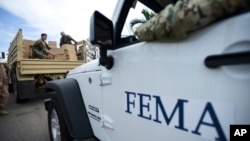A federal report published Tuesday found that staff shortages and a lack of trained personnel slowed the U.S. government response to Hurricane Maria, a storm estimated to have killed nearly 3,000 people in Puerto Rico.
The U.S. Government Accountability Office said 54 percent of federal emergency personnel were not qualified to do the rescue work in October 2017, a month after the Category 4 hurricane hit the U.S. territory. The report also states there were logistical challenges given Puerto Rico’s location and noted that the Federal Emergency Management Agency had to assume many of the local government’s responsibilities given the loss of power and communications.
Christopher Currie, the GAO’s director of emergency management issues, said in a phone interview that FEMA was already stretched thin by responding to hurricanes Harvey and Irma, as well as California wildfires.
“The response in Florida, Texas and California was about what we planned for,” he said. “In Puerto Rico, obviously, it was a much, much different story.”
FEMA did not anticipate not having the support of local government officials in Puerto Rico, who he said were still reeling from the hurricane. In addition, the power grid was destroyed, which meant officials did not immediately understand the scale of the damage because there was no communication for almost a week. Hurricane Maria hit on Sept. 20 and is estimated to have caused $100 billion in damage.
“Once the scale was understood, that’s when FEMA called in the Department of Defense. They said, ‘We’re overwhelmed. ... We need help,’” Currie said. “From a FEMA standpoint, a couple of things happened that they were not anticipating that they probably could have.”
The report also said that FEMA lacked enough Spanish-speaking employees, and that some staffers were not physically fit enough to handle the “extreme or austere” environment.
Currie added that FEMA was already 30 percent understaffed after Hurricane Harvey, and that some personnel were already drained by the storms and fires that hit prior to Maria.
“By the time they got to Puerto Rico, they were very tired,” he said.
FEMA said in a statement that the GAO report captures the complexity of last year’s disasters, adding that the agency issued its own report in July and has already issued recommendations for improvements. The FEMA report in part found that it underestimated how many supplies were needed in Puerto Rico and how difficult it would be to get those to the U.S. territory after the hurricane.
The GAO report states that federal, state and local official also struggled to find temporary housing for those affected by Hurricane Maria. Currently, tens of thousands of people remain without a proper roof at the peak of this year’s hurricane season.
Currie said the recovery from Hurricane Maria remains a big concern.
“There are just a number of huge challenges still to come,” he said.









